 |
The Saint of the Day
St. Abercius – October 22
Prof. Plinio Corrêa de Oliveira
Biographical selection:
In the year 161, when Marcus Aurelius became Emperor, Abercius was Bishop of Hierapolis (in today’s Turkey), a city dedicated to Apollo and evangelized by St. Paul. He was already known for his virtues when an episode occurred that made him famous.
The new Emperor had intensified the cult to the idols and since the city of Hierapolis was consecrated to one of them, the number of processions to the pagan gods there increased. Abercius suffered greatly from this and frequently prayed to God asking for the destruction of the temple idols. One night as he slept, he saw an Angel who handed him a rod and told him: “Wake up! The time has come! Take this rod and strike down the false gods that deceive the people.”
He arose and made haste to the temple, and destroyed Apollo, Hercules, Diana and Venus, breaking them into pieces. Roused by the enormous noise, the priests and guards entered, surprised to find the Bishop there.
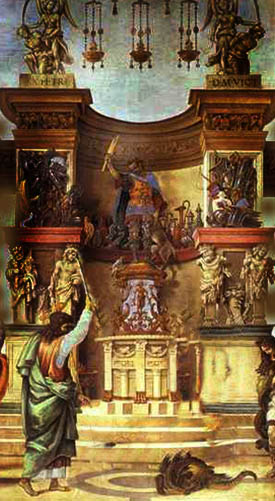
One can imagine St. Abercius striking the temple gods with his rod
|
Abercius told them: “Go and tell the magistrates and the people of Hierapolis that their gods, overstuffed with flesh and wine, became drunk and fell, one on top of another, and are now reduced to pieces. Take away this rubble if you have any use for it.”
With these words he left the temple. No one dared to touch him. He continued on his way to give his customary morning class to his disciples.
Shortly afterward, however, the furious pagans sought him out to kill him. Three men of the city who were known to be possessed, shouting and biting themselves, placed themselves between the Bishop and the crowd. The mob fell silent. Abercius raised his hands over the possessed men and prayed, saying these words: “Almighty God, Father of Jesus Christ, whose mercy infinitely surpasses the malice of men, I beg Thee, free these unfortunate men from the chains of Satan, so that the people may recognize Thee as their true God.”
He touched the possessed men with his rod, and they fell motionless at his feet. He helped them to their feet and they stood before the crowd, safe and sound. Then he told them to return to their houses. Witnessing this spectacle, the multitude called out in unison: “Baptism, baptism! The God of Abercius is the true God!”
After this episode, the fame of St. Abercius spread throughout Asia. People came from far and wide to ask for his help. The Emperor himself asked St. Abercius to heal his daughter Lucilla, who was possessed.
Forewarned supernaturally of his death, he prepared his tomb to be built in marble and wrote a long epitaph, which became known as the Inscriptions of Abercius. He died in 167 with 72 years of age.
Comments of Prof. Plinio:
In this selection there is an answer to a frequent obliteration in presenting the lives of saints.When writing about saints, many Catholic historians make this syllogism: Since this life is a valley of tears and one must walk through it along the way of the cross in the footsteps of Our Lord Jesus Christ, and since all saints suffer a great deal, then the saints should be presented as defeated persons. This is incorrect reasoning, because even though the presupposition is true, the consequence does not necessarily follow.
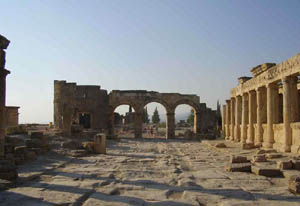
Ruins of Hierapolis, meaning "sacred city," an important Roman city in the 2nd century. Its theater, below, could seat 25,000 people
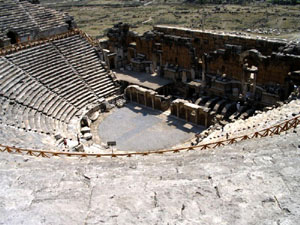
|
Such depictions project the false idea that if a person is not always defeated, not always in a lower place in society, not always assuming an attitude of inferiority before the enemies of Christ, then he is not a saint.
These histories produce a kind of timid, fearful and sentimental Catholic who is scrupulous about being triumphant and victorious. He deems it impious to be intrepid against his enemies, even against the Devil. This produces a decadent type of Catholic who harms the militancy of the Church and encourages all kinds of heresies.
Actually, many lives of saints are made up of defeats. In others, even if the defeats are not frequent, they constitute the most sublime parts in their lives. Catholic life often includes the acceptation of failure as a means to unite with Our Lord.
We should not conclude from this, however, that defeat is inherent to sanctity. The life of St. Abercius is an extraordinary example of the opposite. He appears as a habitually triumphant man who smashes impiety with his virtue and courage, and like a cavalry charge, sets evil to flight, just as we would like to do with the Revolution.
It is interesting that he suffered a great deal because of the presence of idols in Hierapolis, and he prayed to God to destroy them. It is an admirable example for us: we also should suffer because of the new idols of our day – money, pleasure, health, beauty, success, immorality etc – equivalent to the pagan gods of Mammon, Apollo, Bios, Diana, Hercules, Venus etc. What caused his suffering was the offense to God the cult to these idols produced. He could not find joy and satisfaction in life because the glory of God was despised. He felt the need to destroy those idols, but realized the great disproportion between his personal strength and the task he desired to accomplish.
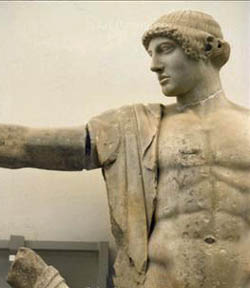
The temple statues, like Apollo above, could not be smashed by the power of one man
|
So he had recourse to prayer. From that prayer the solution came. He had a dream. In it he received a miraculous rod, and an Angel told him to go to the temple and destroy the idols with it. He went, struck the idols with that rod, and they fell to the ground with an enormous clamor.
We can easily imagine the deep silence of a night in a small Roman city at the time of Marcus Aurelius, abruptly broken by the sound of three or four colossal stone idols falling to the ground and breaking into small pieces.
Imagine it as in a theater: it is nighttime, and some rays of the moon illuminate the interior of a temple with its classic Roman lines. St. Abercius approaches, stops at the threshold and peers inside. Then he enters and breaks each of the idols to pieces. These stone statues cannot be felled by simple human blows. But by means of the supernatural force coming from that rod, each idol shakes in its base and tumbles. They fall to the ground with such force that they shatter into small pieces.
Then, in Act Two, the priests and guards rush in with torches. They find Abercius, who calmly faces them. They ask: “Who committed this sacrilege?” Abercius ridicules the gods and justifies his action: “They were overstuffed with the wine and food you offered them. They fell drunk, one over another, and broke into pieces. They were false gods, nothing but this pile of rubble that you are welcome to remove should you have any use for it.”
Then, after speaking these words, he calmly leaves the temple. It is a beautiful pre-figure of the triumph of the Church over Paganism after the decree of Constantine which would be issued in 313.
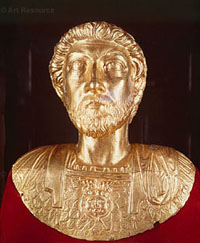
Marcus Aurelius (above) asked St. Abercius to exorcize his daughter Lucilla (below)
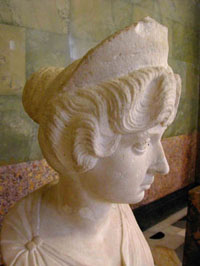
|
Leaving the temple, he goes to give his normal morning class as if nothing unusual had happened. In the city the word is spreading quickly that Abercius destroyed the idols. A mob of furious pagans arrives at the school and Abercius can hear their cries of hatred through the open windows. He ends his class as usual, leaves the building and faces the multitude.
A mob accompanies the pagan priests and witches, the ensemble boiling with hatred. St Abercius appears, calm and majestic. The people look at him and instinctively note the contrast between him and those pagan priests, and admiration for the Bishop sprouts. But the instigators immediately stir up a new wave of hatred.
At that crucial moment three possessed men enter the scene, placing themselves between the populace and the saint. The attention of the crowd focuses on the three, who shout and bite themselves in horrible contortions. Abercius prays over those men and the devils leave them. Seeing this miracle, the mood of the multitude changes and the people convert. The idolater priests and witches are completely defeated.
God, who desired so many saints to shed their blood for His glory, desired St. Abercius to triumph. He wanted Abercius to represent His victory and glory on earth.
His fame spreads everywhere. The Emperor hears of him, and asks him to cure his own daughter who is also possessed by devils. Abercius cures her. This time Abercius does not stand before a furious mob, but confronts the pagan Emperor. Marcus Aurelius, considered by many as representing the apex of pagan wisdom, witnessed this clear manifestation of the truth of the Catholic religion, but he did not convert. He continued on in his paganism and bad faith.
So, St. Abercius the victorious enters history unmasking Paganism and showing its bad faith. We should pray to him asking for his courage and confidence in Divine Providence so that we might have similar victories against the Revolution for the glory of God and Our Lady.


  | | Prof. Plinio Corrêa de Oliveira | |
The Saint of the Day features highlights from the lives of saints based on comments made by the late Prof. Plinio Corrêa de Oliveira. Following the example of St. John Bosco who used to make similar talks for the boys of his College, each evening it was Prof. Plinio’s custom to make a short commentary on the lives of the next day’s saint in a meeting for youth in order to encourage them in the practice of virtue and love for the Catholic Church. TIA thought that its readers could profit from these valuable commentaries.
The texts of both the biographical data and the comments come from personal notes taken by Atila S. Guimarães from 1964 to 1995. Given the fact that the source is a personal notebook, it is possible that at times the biographic notes transcribed here will not rigorously follow the original text read by Prof. Plinio. The commentaries have also been adapted and translated for TIA’s site.
|
Saint of the Day | Home | Books | CDs | Search | Contact Us | Donate

© 2002- Tradition in Action, Inc. All Rights Reserved
|
 |

|